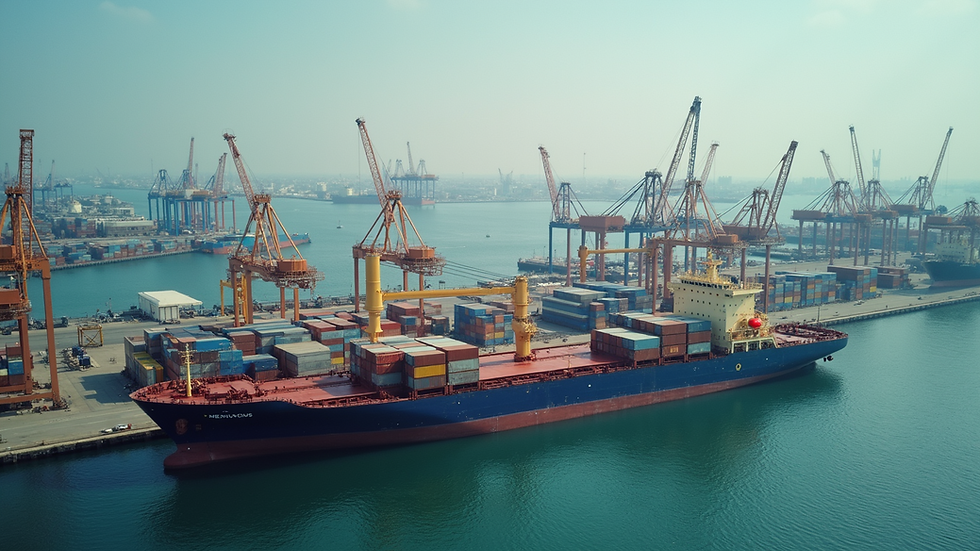Key Factors to Know About Global Trade Rules
- Manson Chan
- Aug 16
- 4 min read
Global trade rules are essential for understanding how goods and services move across international borders. With globalization on the rise, it's crucial for businesses and individuals alike to be aware of the fundamental principles that govern these transactions. This article discusses the key factors you need to know about global trade rules, their implications, and how they impact businesses around the world.
Understanding Global Trade
Global trade refers to the exchange of goods and services between countries. In today's interconnected world, these transactions can range from small businesses selling products online to multinational corporations conducting complex supply chains. The framework of global trade involves agreements and rules that countries adhere to in order to facilitate and regulate trade.

The World Trade Organization (WTO) plays a major role in establishing these rules. The WTO aims to create a level playing field for all trading nations by promoting free trade and ensuring that trade flows as smoothly and predictably as possible. It manages various agreements that countries negotiate, impacting tariffs, subsidies, and trade barriers.
Key Principles of Global Trade
The principles of global trade are fundamental to ensuring fair and equitable trade practices among countries. Here are the key principles that shape international trade:
1. Most-Favored-Nation (MFN) Treatment
The MFN principle means that if a country offers a trade concession to one nation, it must extend the same benefit to all other countries in the WTO. This prevents discriminatory practices and helps maintain low tariffs across the board.
2. National Treatment
Once goods enter a market, they should be treated the same as domestically produced goods. This is known as the National Treatment principle. It prohibits countries from imposing discriminatory taxes or regulations on foreign products, thus leveling the playing field.
3. Transparency
Transparency is key in global trade. Countries are required to publish their trade regulations and practices clearly and openly. This allows traders to understand the rules and comply with them, reducing barriers to entry.

Trade Agreements and Their Impact
Trade agreements are vital in shaping global trade rules. They can be bilateral, involving two countries, or multilateral, involving multiple nations. These agreements help reduce tariffs, remove quotas, and create a predictable trading environment.
Regional Trade Agreements
Examples of regional agreements include the North American Free Trade Agreement (NAFTA) and the European Union (EU) trade agreements. These pacts foster closer relationships between member countries and facilitate smoother trade. However, they may also lead to trade diversion, where trade shifts from non-member countries to member countries, impacting global trade dynamics.
Economic Partnerships
Economic partnerships, such as the Comprehensive and Progressive Agreement for Trans-Pacific Partnership (CPTPP), can also reshape how countries trade. These agreements typically promote not just trade but also investment and collaboration in areas such as technology and labor standards.
Bilateral Agreements
Bilateral agreements, like those between the United States and various countries, are tailored to the specific needs of the involved nations. They allow for flexibility and can address issues unique to the countries' economies, such as intellectual property protections or agricultural exports.

Challenges in Global Trade
While regulations and agreements help streamline global trade, various challenges can disrupt this process. Some common challenges include:
1. Trade Barriers
Tariffs, quotas, and non-tariff barriers can impede trade. Tariffs increase the costs of imported goods, making them less competitive compared to local products. Countries may impose quotas to limit the volume of imports, which can lead to shortages or inflated prices for consumers.
2. Regulatory Differences
Divergent regulations between countries can pose significant challenges. Differences in product safety standards, environmental regulations, and packaging requirements can affect how easily products enter foreign markets.
3. Political Risks
Political instability can also impact trade. Changes in government, civil unrest, or shifting international relations can lead to uncertainty. Businesses operating in or with countries facing such risks often must develop contingency plans to navigate potential disruptions.
Future Trends in Global Trade
Looking ahead, several trends are shaping the future of global trade.
1. Emphasis on Sustainability
As awareness about climate change grows, sustainability is becoming a critical component of trade. Consumers are demanding eco-friendly products, and companies are increasingly looking for sustainable supply chains. This shift will likely result in new regulations and standards that prioritize environmental concerns.
2. Digital Trade
The rise of e-commerce and digital services has transformed the way trade is conducted. Digital trade encompasses everything from online retail to data flows and cloud services. Countries are beginning to negotiate agreements focused specifically on digital trade, creating a new set of rules for this evolving landscape.
3. Resilience and Localization
The COVID-19 pandemic exposed vulnerabilities in global supply chains. Companies are now focusing on resilience, leading to a trend towards localized production and shorter supply chains. This shift could also influence trade policies and compliance with international trade regulations.
Navigating Global Trade Rules
Understanding and navigating global trade rules is crucial for any business involved in international trade. Here are some practical recommendations:
1. Stay Informed
Keep updated on changes in laws, trade agreements, and tariffs that could impact your business. Websites like the WTO and relevant government trade departments often provide valuable resources.
2. Consult Experts
Consider working with trade experts or legal advisors who understand international trade regulations. Their insights can help you navigate complexities and avoid potential pitfalls.
3. Build Relationships
Establishing relationships with local distributors and partners can help you better understand local markets and regulations. Networking through trade organizations and industry conferences can also provide valuable contacts.
4. Focus on Compliance
Ensure your operations fully comply with local laws and international trade regulations. This includes understanding import/export requirements, tariff classifications, and documentation needs.
5. Adapt Strategies
Be prepared to adapt your business strategies based on changes in global trade dynamics. Flexibility can be key to maintaining competitiveness in an ever-evolving market.
Final Thoughts on Global Trade Rules
Global trade rules play a critical role in fostering international cooperation and driving economic growth. By understanding and adapting to these rules, businesses can enhance their competitiveness and open new market opportunities. As the landscape of global trade continues to evolve, staying informed and agile will be essential for success.
The world of trade is both complex and rewarding, offering significant potential for those willing to engage with it thoughtfully and strategically.












Comments